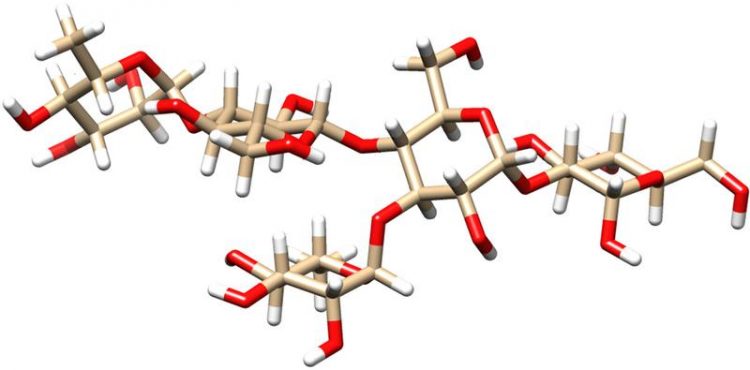Novel therapeutics recognize sugar coat of the hospital germ C. difficile

Sweet target of therapeutic antibodies: the sugar molecule „PS-I“ of C. difficile is shown in its three-dimensional shape (orange: carbon; red: oxygen; white: hydrogen). © MPI of Colloids and Interfaces
Hospital-acquired infections are a rapidly increasing problem in industrialized countries as more antibiotic-resistant bacteria evolve. The anaerobic bacterium Clostridium difficile has emerged as a major cause of disease in hospitals and long-term care facilities where up to 40% of inpatients are infected.
The bacterium blooms in the gut when protective bacteria are diminished by antibiotics. Symptoms include diarrhea, dehydration, intestinal inflammation and death in severe cases.
As antibiotic resistance continues to rise, novel therapies are needed urgently. In the US alone, over 250.000 C. difficile infections annually are responsible for at least 15.000 deaths and medical expenses of over one billion dollars.
Researchers at the Max Planck Institute of Colloids and Interfaces now report monoclonal antibodies against the sugars on the surface of C. difficile as a novel antibacterial therapy. Chemically synthesized sugars that resemble those covering the bacterium were used to generate monoclonal antibodies that specifically recognize and kill any pathogen carrying the motif.
Since the sugar motif called PS-I is found on a wide range of C. difficile strains, the novel therapeutic is expected to be very broadly applicable. Another advantage is that other bacteria of the gut remain intact and lower the likelihood of re-infection by C. difficile that is a common result of antibiotic treatment.
The results reported in Nature Communications are the basis for ongoing efforts to develop novel therapeutics. “This is a great example how basic research on fundamental aspects of the human immune response results in therapeutic candidates that will help fight one of the most devastating hospital-acquired infections” says Prof. Peter Seeberger, the senior author of the study.
The team at the Max Planck Institute of Colloids and Interfaces in Potsdam continues to work with Vaxxilon AG (Reinach, Switzerland) to advance novel carbohydrate vaccines. Vaxxilon has licensed certain intellectual property rights to a portfolio of vaccine candidates targeting multiple infectious agents, including C. difficile.
Media Contact
All latest news from the category: Life Sciences and Chemistry
Articles and reports from the Life Sciences and chemistry area deal with applied and basic research into modern biology, chemistry and human medicine.
Valuable information can be found on a range of life sciences fields including bacteriology, biochemistry, bionics, bioinformatics, biophysics, biotechnology, genetics, geobotany, human biology, marine biology, microbiology, molecular biology, cellular biology, zoology, bioinorganic chemistry, microchemistry and environmental chemistry.
Newest articles

Superradiant atoms could push the boundaries of how precisely time can be measured
Superradiant atoms can help us measure time more precisely than ever. In a new study, researchers from the University of Copenhagen present a new method for measuring the time interval,…

Ion thermoelectric conversion devices for near room temperature
The electrode sheet of the thermoelectric device consists of ionic hydrogel, which is sandwiched between the electrodes to form, and the Prussian blue on the electrode undergoes a redox reaction…

Zap Energy achieves 37-million-degree temperatures in a compact device
New publication reports record electron temperatures for a small-scale, sheared-flow-stabilized Z-pinch fusion device. In the nine decades since humans first produced fusion reactions, only a few fusion technologies have demonstrated…





















